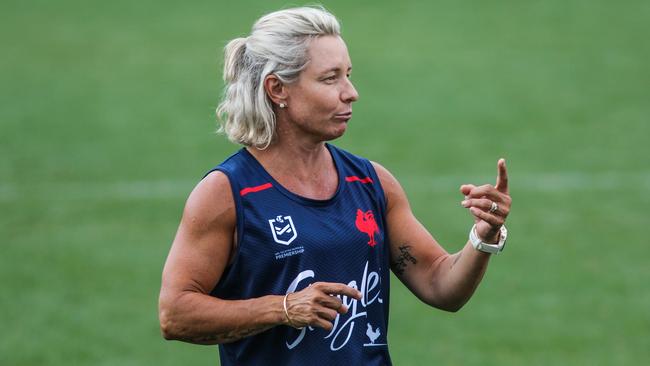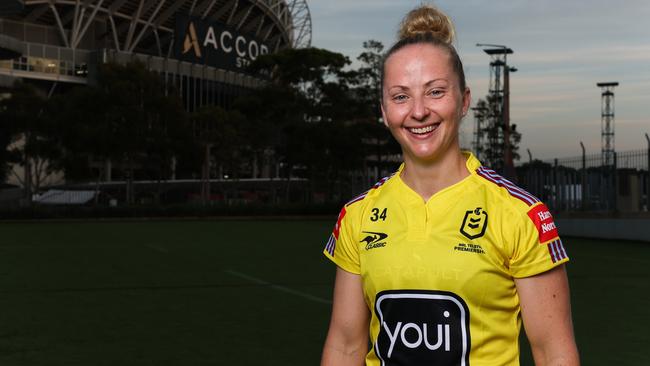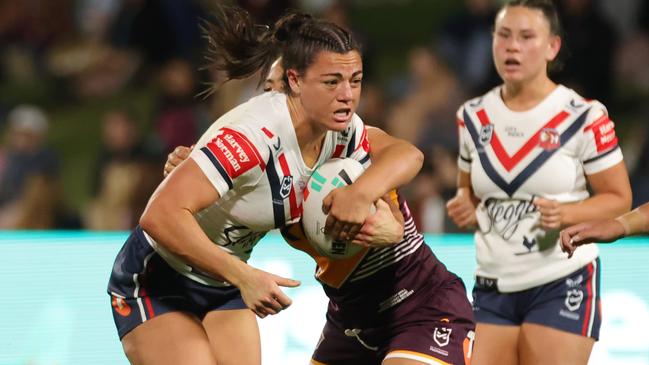Biggest issues facing women in rugby league: How long until a woman coaches in the NRL?
To crack an environment with every advantage afforded to men is difficult, let alone to do it as a woman. We reveal the biggest issues facing women in rugby league.

NRLW
Don't miss out on the headlines from NRLW. Followed categories will be added to My News.
How long until we see a woman coaching in the NRL?
It’s an inevitable question that may as well be, ‘how long is a piece of string?’.
NSW coach Kylie Hilder is one of a handful of women involved in high level coaching positions in the game, and even she finds it hard to imagine the slow-moving wheel of change turning faster than it is currently.
In the NRLW there is just one woman, Gold Coast’s Karyn Murphy, with a head coaching job out of 10 positions.
This season there are seven NRLW assistant coaches (including Hilder at the Roosters), which has risen from three last year.
That’s a win, but one thing Hilder does know is nothing will change without the genuine support of men in the game.
“I’m very grateful in that I have Freddy (NSW coach Brad Fittler) who has been such a great mentor for me since I took over at Origin,” she says.

“We’ve got that relationship where I don’t ever hesitate if I’ve got an issue or I want to run something by him, I pick the phone up. In the NRLW it’s the same with (Roosters head coach) John Strange.
“We can maybe try and get some of these women with male coaches as mentors to try and give them that confidence as well, but it’s got to be the right person.
“Trying to create some more educational opportunities for our coaches is the first step.”
Hilder was one of the first women, along with Queensland coach Tahnee Norris, taking on elite coaching courses to take the next step in her career once she finished playing football.
But progress at the top has been extremely slow for a number of reasons.
Hilder says the reason there aren’t more female coaches is simply because there aren’t many who are ready yet, and that’s because the education system doesn’t work properly.
Coaching is extremely competitive and there are few employment opportunities across the game.
To crack that environment with every advantage afforded to men is difficult, let alone to do it as a woman.
Hilder believes female specific coaching courses are the first step to change.
“When I came through and did my senior club coaching course I was the only female room full of 30 males doing a high performance coaching course,” she says.
“That could be really intimidating and I’ve been around football for a long time working in it, so I was ok.
“But there’s a lot of women who won’t take that next step to get that qualification to take on a coaching role either.
“We probably need to start looking at having some female specific courses to get them to that next level to give them that confidence.”

We are seeing some slow change, though.
In 2018, all head coaches at the inaugural Women’s National Championships were men, but by 2023 that number had risen to 75 per cent (or nine of 12).
There’s also been the rise in female NRLW assistants, as well as in female Jillaroos staff on the last World Cup tour (75 per cent, up from 25 per cent at the 2017 tournament).
For Hilder, the biggest thing is taking tokenism out of the equation and ensuring the people in these roles are properly qualified for them.
Two years ago she said she wasn’t ready to be the head coach of an NRLW side, but now she’s getting closer to the confidence she needs.
“I always wanted to make sure I was ready to offer what a head coach should offer to a team,” she says.
“Coaching Origin now and being under John Strange for the last two years, I’m getting to that point where it’s something I would look at.
“The biggest thing for me is we should be putting people in there who are right for the jobs instead of having token females in those jobs.
“We should be giving women every tool they need to be able to cope when they’re a head coach, so when they go in there, they’re ready. If that takes a couple of more years then so be it.”

EMPLOYMENT
Around 34 per cent of NRL employees are women and that needs to increase.
As with coaching, and almost every male dominated area in society, that number won’t move without giving women support to help them into suitable positions.
In rugby league, women are represented at almost every level of the game and in all areas of the business, in football departments, executive positions, administration and media roles, but there is still a lot of work to do.
“We know we have to get better and we know we have to do better, and you’ve got to be eternally vigilant to it,” said ARL commissioner Professor Megan Davis at the Women in League round launch this week.
“This round is really important to us and always has been, but it’s things that you do outside of this round in terms of enhancing women’s entry into the sport is really critical to see the game flourish in terms of women and girls.”
PARTICIPATION
The sixth season of NRLW is under way and the impact it’s had on the women’s game across the country is astronomical.
The idea of ‘you can’t be what you can’t see’ has taken on new meaning in grass roots rugby league now that there’s a direct pathway to elite football for young girls across the world.
This year there’s 39,164 registered female players in club rugby league across Australia, which is up 14 per cent from this time last year (34,880 in 2022 and 33,136 in 2021).
For a long time it’s been the fastest growing area of the game, but big investment at the top if encouraging new talent into the game, the creation of more female academies, tournaments and even rugby league specific school programs for teenagers.

REFEREEING
Refereeing is an intimidating space to get into and even more so for young women.
But it is an area of the game that’s growing too, and being driven by two women at the top, Belinda Sharpe and Kasey Badger.
As the highest profile female NRL referees, they are the example that a career with a whistle is achievable, but even they haven’t yet reached the pinnacle of their sports.
And they’re overwhelmingly outnumbered.
A woman has never officiated a men’s State of Origin match, or an NRL grand final, so there’s still room to move at the elite level and there needs to be a bigger push to get there.
NRLW
The expansion to 10 teams has been a huge achievement but it’s a constant balancing act to manage for the NRL.
Not expanding quickly enough would squash progress, but too rapidly would ruin the quality of the competition.
But there are other issues preventing the women’s game from being the best it can be at the moment.
This weekend is the second round of the NRLW for the season and the women still are not protected by a complete collective bargaining agreement due to an ongoing battle between the governing body and the players’ union.
The players have contracts and terms already agreed, but as the fight for a men’s and women’s CBA gets uglier, so does the damage to the women’s game.
For instance, this weekend players across NRL and NRLW will cover the logo on their jerseys with tape in protest to encourage action on their outstanding agreement.
Canberra, who are new to the NRLW this year, will play their historically significant first home game at GIO Stadium.
Those special images and memories will be around for decades to come, and will be held dear to the hearts of those players and their families.
But the black tape on their jerseys will pull focus from it all.
RLPA’s ACTU alliance and the email set to break NRL
—Brent Read
Just when you thought it couldn’t get any worse, an email lobbed at 12.36pm on Tuesday afternoon.
Rugby League Players Association boss Clint Newton, unable to strike a deal with the NRL for his players, had decided to drag the ACTU into rugby league’s civil war.
Rumours of a meeting with ACTU boss Sally McManus had been sweeping through the sport in recent days and then the email dropped, offering a photo opportunity involving McManus and Newton. God help rugby league.
The RLPA claimed in the release to be looking for solidarity in their fight for a fair deal? How about solidarity with the fans who love the game and pay their wages? How about solidarity with the broadcasters who fund the game?
How about having the game’s best interests at heart? How is it in the game’s best interests to drag in the ACTU? It’s the final insult to fans in this country who are fighting for every dollar. Who scrape by and rely on the ACTU to help them survive.
Newton is seemingly drawing a line between their fight and that of rugby league players, the overwhelming majority of whom make a healthy living and don’t have to worry about finding enough money to put food on the table.
The minimum wage in rugby league is now in excess of $120,000 each year. The average wage is close to $400,000 a season. Compare that with the average Aussie, who exists on a minimum wage of just over $45,000 and an average salary of around $90,000. That’s who the ACTU be worried about rather than having its attention diverted by the RLPA.


This isn’t about the players any more. It’s about the RLPA and their bid for more power. The more they have been given during this negotiation, the more they have wanted.
All this on the day that Women in league round was launched with not a player in sight. You want to know the real victims of the player union’s silly boycott of the media, you only had to take the stairs up to level one of the Pullman Hotel and take a peak inside the room.
Male and female players are free to speak in the early part of the week but given the existing situation, the NRL couldn’t take the risk of having a player walk in the room and hijack the event with silly talk about the CBA or boycotting the Dally Ms.
Among the heavy hitters, the blame was only being pointed in one direction. It wasn’t at the NRL or the players themselves. It was at the organisation and the people who have championed the decision to snub the media, naively thinking in some way that it would help their cause.
Instead, they are doing untold damage to the game. Or more particularly, the game’s female players, who have become the innocent victims in this ridiculous war.

They have an agreement in place. Yet they have shown solidarity with the men and adopted the boycott as well. They should be spruiking their game and doing whatever they can to showcase their talents.
Instead, their mouths are shut on weekends and the game suffers. Alarmingly, we had one match at the weekend where not a member of the Sydney media turned up at the press conference, leaving Dragons coach Jamie Soward in a lather.

Soward has worked in the media himself. It wasn’t his fault. But if he wants to point a finger, point it at an organisation that thought it was a smart idea to take their frustrations out on the media.
It isn’t just the women’s game that has suffered. Manly captain Daly Cherry-Evans, who has been in the middle of the CBA fight, will play his 300th game this weekend and he should be celebrated as one of the game’s great champions.
He will get plenty of adulation, but nowhere near the amount he deserves. Cherry-Evans is doing media on Tuesday but after that, the shutters go up. Under the RLPA edict, he will be off limits for the rest of the week.
At least Cherry-Evans has had his time in the sun. The time has now come for the women’s game to shine but their union has cut them off at the knees.
More Coverage
Originally published as Biggest issues facing women in rugby league: How long until a woman coaches in the NRL?





